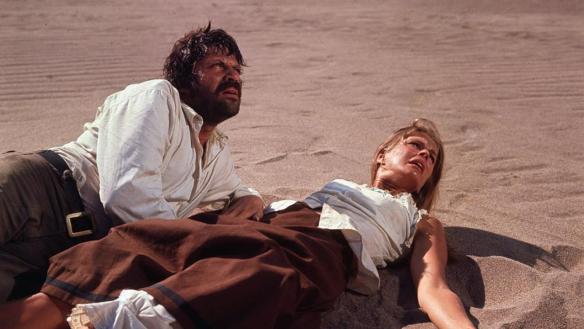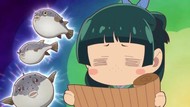Hello folks, and welcome back to Wrong Every Time. This week I’ve been avoiding the summer heat by playing a whole ton of Death Stranding 2, which is proving both immensely compelling and also quite different from its predecessor. I can see why Kojima was worried that his playtesters were “enjoying it too much” – the franchise has largely abandoned the austerity of both form and function that defined its predecessor, that singular sense of loneliness and unending toil that made it a distinct emotional experience within the medium. In contrast, Death Stranding 2 embraces enough of Metal Gear Solid 5’s mechanics to offer a crowd-pleasing summation of Kojima’s career to date, meaning it’s less of a revelatory art experience than simply a damn good videogame. It has nonetheless got its hooks in me deep, but I still managed to spare enough time to sneak in some film viewings. Let’s get to it!
First up this week was The Hunting Party, a ‘71 western starring Gene Hackman as a sadistic cattle baron, whose wife (Candice Bergen) is abducted by a notorious outlaw (Oliver Reed). Hearing of the kidnapping, Hackman elects to transform his steer-hunting expedition into a man-hunting trip, determined to destroy the man who besmirched his honor. He is aided in this quest by a posse of allies and several terrifying rifles, capable of killing targets at up to 800 yards.
The Hunting Party is a lean, dark, and unforgiving feature, one of those bleak westerns that sees little good in any aspect of humanity. Art director Enrique Alarcón makes a hateful wasteland of Southern Spain, while director Don Medford exploits Oliver Reed’s wounded eyes and private madness to electrifying effect, contrasting the depravity of his actions and conditions with a glittering intelligence and even romantic spirit, all subjugated beneath the demands of outlaw living. The film finds less profundity than it seeks in its relentless cynicism, but nonetheless allows some dynamite actors a fine chance to destroy themselves on-screen.
We then checked out the just-released KPop Demon Hunters, a presumably self-explanatory animated feature directed by Maggie Kang and Chris Appelhans. The film centers on the K-pop trio of Rumi, Mira, and Zoey, who collectively form Huntrix, a stadium-filling group who are secretly carrying on an ancient tradition of musical demon hunting. But their unity is threatened by their leader Rumi’s long-held secret, and when the demon Jinu forms a boy band to challenge them, the mortal realm will be thrown into peril.
Given my general distrust of the idol industry, I was fully expecting my cynical breakwaters to hold firm against KPop Demon Hunters’ relentless waves of optimistic celebration. Sadly, the levees broke even faster than I anticipated, and I confess I had a lovely time with Rumi, Mira, and Zoey. The narrative is basically just a template, and the conclusion resolved so little it felt like an actively sequel-conscious decision, but it’s just hard not to like our leads here; they’re distinctive alone and charming together, playing off each other’s eccentricities and winningly expressing their confidence and mutual love through their music.
KPop Demon Hunters also boasts a solid collection of songs, and offers a compelling new evolution of Into the Spiderverse’s low-frame cel-shaded aesthetic, with the song sequences in particular demonstrating marvelous use of color design and dynamic cinematography. The more gag manga-indebted character acting sequences felt a little off to me, as the characters models don’t exactly lend themselves to wild distortions of form, and CG naturally lacks the fluidity to bridge such a gap. Nonetheless, I’m always happy to see CG artists expanding their repertoire, and found myself thoroughly charmed by the Demon Hunters. After a hundred-plus episodes of Sailor Moon, my first reaction to finishing this one was an instinctive, unbidden “yeah, I’d watch a season of that.”
Our next viewing was Class of Nuke ‘Em High, an ‘86 horror-comedy produced by renowned purveyors of filth Troma Entertainment. The film centers on the students of the nuclear power plant-adjacent Tromaville High School, whose students end up alternately mutated by the plant’s radiation or attacked by their fellow mutants. There’s sex, violence, and a whole heap of green slime, all the key ingredients of a proper American adolescence.
Nuke ‘Em High served as my introduction to Troma Entertainment, who are renowned for such B-movie staples as The Toxic Avenger and Tromeo and Juliet (see, it’s like Romeo, but with a “T” for Troma). This film offers roughly the level of wit and ingenuity you’d expect from such distinguished producers; it only infrequently works as comedy, basically never works as horror, and mostly just offers the occasional flourish of nightmarish pubescent body horror, capitalizing on the fertile intersection of adolescent bodily fears and outrageous practical effects. Also, I absolutely loved “The Cretins,” a group of former honor students who are transformed by radiation into a variable collection of punk rockers, war boys, and Escape from New York extras. The film is never particularly good, but it’s exuberant and lighthearted and clearly crafted with a lot of love.
Last up for the week was Fantastic Planet, a ‘73 French-Czech animated film directed by René Laloux, from a book by Stefan Wul. The film takes place on the planet Ygam, inhabited by giant humanoids known as Draags, who live in an advanced psychic society and keep humans (referred to as “Oms”) as pets. When one Om known as Terr is accidentally introduced to Draag education, he incites a revolution that will reshape the fabric of their world.
Fantastic Planet is generally regarded as one of the classics of world animation, standing along such iconic features as Son of the White Mare and Belladonna of Sadness. However, its visual style stands apart from the morphing fluidity of White Mare or most Japanese animation, instead calling to mind the surreal, almost cut paper-adjacent stylings of Yellow Submarine or Terry Gilliam’s animation. Though there is a story being told here, much of the film is given over to simply marveling at the strange world of Ygam, and the dangerous beasts that inhabit it.
This is a good thing, because as a narrative, Fantastic Planet is not particularly compelling. The film starts off with a reasonably sound allegory regarding how intelligent races treat their alleged inferiors, but the message is simplistic, more just a vehicle for imagery than a cutting comment on society. And the film’s third act basically doesn’t exist; we watch through the point of our heroes being struck low, but then summarize their resurgence, with their final victory literally being described in voiceover as “we somehow found a way to defeat them.” Granted, this is a film about aesthetics more than drama, but as a critic situated directly at the intersection of animated aesthetics and storytelling, I have to protest that the abundance of one does not demand the absence of the other. Nonetheless, Fantastic Planet remains a singular visual experience, and is indeed a film that any fan of animation should see at least once.




